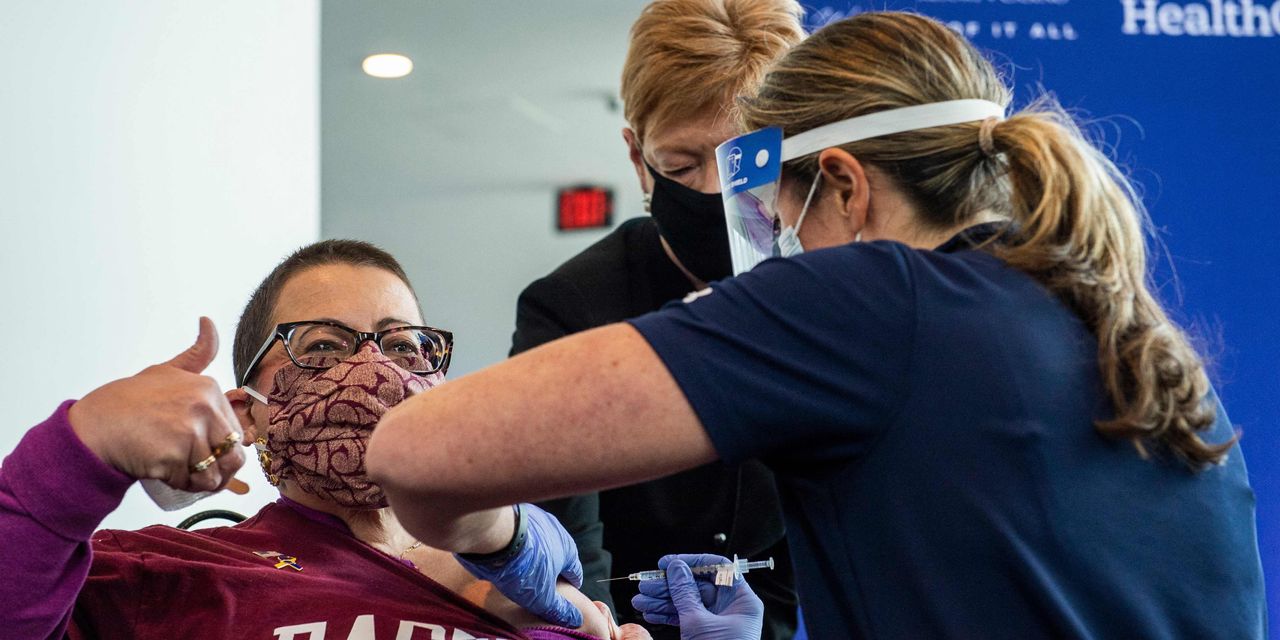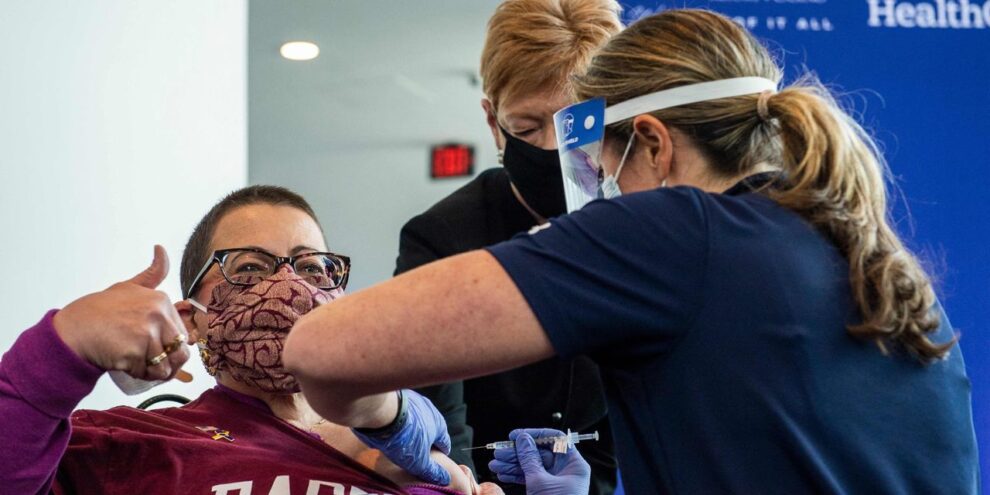
Though access to COVID-19 vaccines remains limited, polling suggests a slice of Americans want to “wait and see” how the shots work for other people before they get vaccinated themselves.
But experts say that getting the vaccine as soon as it’s available to you will be vital for protecting yourself and others, stopping virus variants in their tracks, and resuming some level of normalcy.
The share of people in this “wait and see” category has declined over time, according to polling by the health-policy think tank Kaiser Family Foundation, dropping from 39% in December to 31% in January. In February, the most recent survey, it stood at 22%. This happened alongside a gradual increase in the share of respondents (most recently 55%) reporting they’d either gotten at least one dose or would get the vaccine as soon as possible.
Black adults (34%), young adults aged 18 to 29 (33%), Hispanic adults (26%), adults without a college degree (25%), and non-health essential workers (25%) had the highest shares of respondents in the wait-and-see group.
The most common concerns in the wait-and-see cohort were the potential for serious side effects; the possibility of getting COVID-19 from the vaccine, which health authorities say cannot happen; the prospect of missing work due to side effects; and the potential need to pay out of pocket for the vaccine, though the vaccines are free. A quarter of wait-and-seers said a one-dose vaccine would make them more likely to get their shot.
Susan Lopez, a hospitalist affiliated with Rush University Medical Center in Chicago, says community members have raised questions about waiting to get vaccinated against COVID-19 during every one of the 12 vaccine-outreach sessions she has done.
“I get a lot of questions about long-term effects, like months and years later on, especially with regards to mRNA vaccines since they keep hearing it’s new technology,” Lopez told MarketWatch. Many people also feel overwhelmed by the technological logistics of registering for a vaccine appointment, she added.
Lopez said she tells community members who say they want to wait that she’s there to provide them with the information they need to make the decision best for them. But she reassures them that no safety steps were skipped in the vaccine-development process, that all of the vaccines have been studied, and that researchers will continue to gather safety information.
Lopez stressed the importance of asking people why they want to wait rather than assuming. Healthcare professionals should acknowledge that those feelings are valid, she said, while also answering questions and providing information.
About one-fifth of respondents to KFF’s latest survey said they definitely wouldn’t get vaccinated (15%) or would do so only if required (7%). But KFF chief executive Drew Altman likened the wait-and-see cohort to “persuadable swing voters.” He reasoned they should be a key focus in efforts to shore up vaccine confidence, “especially in Black and Latino communities where the need for building vaccine confidence and addressing information needs and barriers to access is the most urgent.”
He also predicted many may get their shots after seeing people they know get vaccinated without incident.
“The ones whose minds can be more readily changed are in the wait-and-see group — and hopefully all of their minds can be changed,” said David Abramson, a clinical associate professor of social and behavioral sciences at the NYU School of Global Public Health who is doing research on vaccine hesitancy and was not involved in KFF’s research.
“If that was the case, we’d get closer to an 80% [coverage] rate, and that would be terrific,” Abramson added. “We’d be at the herd-immunity rates that we’d want to be at.”
The Food and Drug Administration has granted emergency-use authorization to the two-dose Pfizer PFE, +0.66% -BioNTech BNTX, +0.66% and Moderna MRNA, -2.48% vaccines, as well as the one-shot Johnson & Johnson JNJ, +0.29% vaccine.
As of Thursday afternoon, 64 million people in the U.S. (19.3% of the total population) had received at least one vaccine dose, and 33.8 million (10.2% of the population) were fully vaccinated, according to the U.S. Centers for Disease Control and Prevention.
‘I generally scare them about how bad COVID can be’
What’s the rush to get vaccinated? For starters, the longer you wait, the longer you aren’t protected from COVID-19, said Alison Buttenheim, a behavioral epidemiologist at the University of Pennsylvania School of Nursing.
People tend to have concerns about vaccine safety and efficacy, she added, but many don’t appropriately weigh the risks of the disease they’re trying to prevent. “It’s really easy to only focus on the benefits and potential harms and risks of the vaccine, and just ignore the disease,” she said. “We all misestimate our risk.”
William Parker, an assistant professor of medicine at the University of Chicago with firsthand experience caring for patients with severe COVID-19, says he emphasizes to wait-and-see people that they don’t want to wind up seeing him in the hospital.
“I generally scare them about how bad COVID can be,” Parker said. “What’s so exciting about the vaccines is they are tremendously effective at preventing these really bad outcomes — hospitalizations and deaths.”
The virus had killed more than 530,000 people in the U.S. as of Thursday, according to Johns Hopkins University.
A race to ‘starve the virus of hosts’ — and ward off variants
The urgency stems from a need to “starve the virus of hosts,” Abramson said. Public-health professionals want to cut down the number of people in a community who are potential carriers and transmitters of the virus, he said, so to the extent that more and more people get vaccinated, “that will soon begin to suppress the virus population itself.”
Health professionals also want to rapidly suppress the number of people sick with COVID-19, Abramson added — “and for every day that people wait and do not get vaccinated, that’s one more day that they have at least the possibility of getting sick, and in the worst-case scenario, being hospitalized and maybe even dying.”
“To me, speed is really the answer here,” he said.
The threat of COVID-19 variants also makes vaccination a time-sensitive goal, experts say. The variant first identified in South Africa, for example, is more infectious and appears to make coronavirus vaccines less effective. A senior U.K. scientist warned last month that the far-more-infectious variant first identified in the U.K. may “sweep the world.”
“As the virus has more time and more hosts to interact with, there is a greater possibility that additional variants will emerge, or the variants that are currently circulating will get more of a foothold in the population and become more of a serious issue,” Abramson said. “It’s really just a mathematical game of reducing the number of potential hosts.”
Lopez added, “Every opportunity that we have to protect people earlier rather than later is going to be a chance to save a life or to save someone from having long-term COVID effects.”
‘A pathway back to normalcy’
The CDC said this week that fully vaccinated people can gather indoors and unmasked with other fully vaccinated people. They can also do so with unvaccinated people from one other household, assuming no one in that household is at heightened COVID-19 risk.
(Fully vaccinated people, meaning those who had their second or only vaccine dose at least two weeks earlier, still need to wear masks and practice physical distancing in public settings, the guidance added.)
The CDC guidance, along with any additional state-level guidance, will provide “a pathway back to normalcy” for many people, Abramson said. “The faster people get vaccinated, the faster they will be able to take advantage of changes in distancing protocols, protective measures, etc.,” he said.
“My wife and I are fully vaccinated, [and] one of my colleagues and his wife are fully vaccinated, so we all had dinner together,” Parker added. “That’s totally acceptable once you’re fully vaccinated.”
And from a herd-immunity standpoint, Buttenheim said, “the quicker we can get to 70% or 80% coverage in the country, the quicker we can pick up our lives again — and, if this is important to you, keep vulnerable people safe.”
One altruistic reason to get vaccinated as soon as the shot is available to you is to set a visible example for others, particularly if you’re from a group that’s experiencing high levels of vaccine hesitancy or potential delay, Buttenheim added.
“We’re really social creatures, and we definitely look around our social environments to get cues on what to do,” she said.
Three vaccines, ‘all great’
Experts have also raised concerns about Americans passing up the vaccine they’re first offered and waiting for a “more effective” option — the result of disparate topline vaccine-efficacy numbers that scientists say shouldn’t be directly compared.
The Pfizer and Moderna mRNA vaccines boast a roughly 95% efficacy rate, but their trials were conducted prior to rising concerns about coronavirus variants, against which J&J’s 66%-efficacious viral vector-based vaccine was tested. The global J&J efficacy figure also obscures the vaccine’s 72% efficacy in the U.S. and 85% efficacy against severe disease.
While the two mRNA-based vaccines are different from the J&J vaccine in several key ways, all three are effective at preventing severe disease, hospitalization and death — the measures that matter most, according to public-health experts.
“The information I give [people] is essentially, no matter which vaccine you get, it’s preventing hospitalization and death — so the best one is going to be the one they can get to first,” Lopez said.
Buttenheim agreed. “We just want people to get the vaccine that they’re offered,” she said. “They’re all great.”
Also read: Americans debate what COVID-19 vaccine they want, but Fauci says to take what’s available to you





